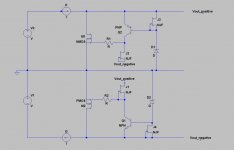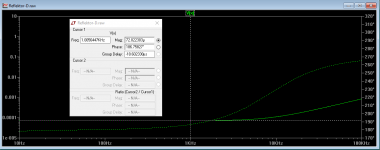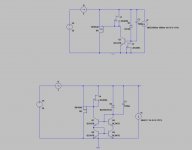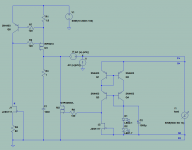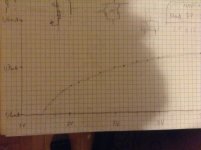yes jfet mod, which lowers Output impedance, should give more ''drive'' to the music...a bit like raising the overall CCS current does.
one could also try 2n5457, which for some reason give stunning dynamics and tone, to the cost, i believe, of somewhat higher noise.
....to be tried elsewhere too! 🙂
If better using a sample that does not have more than 1V Vgs (off) in this case
Okay, I did the JFET mod and currently listening to the result. The swapping with 2mA Idss k117y was okay to make the output voltage remain the same.
Subjectively, I think the JFET results in a lower noise floor, more micro details coming through and a bit of more stereo depth. Also there is more feel of "sterility" in the sounds, but I prefer letting things burn-in before making the final judgment.
Exactly, R6 seems less focused but more relaxed when a system wants that. Hence I leave the option open to the final user in the Big Ref-D. R6 quality plays a role too. Vishay VAR was subjectively different than generic in our older tests.
It also gives to the JFET (if used) more VDS space (MOSFET's VGS).
isn't it just exactly the MOSFET itself and not the topology itself that makes JFET Vds...?

edit: maybe that in the BIB, the bjt making the Vbe part of the output voltage needs some headroom to perform best...?
Last edited:
R6 or JFET sits under M2's VGS. Which is 3xVbe. In BIB its only 1xVbe. Trying to lift that with a diode has a hit to very low frequencies Zo. It can be also done having much VDS in cross coupled symmetric BIB builds. I.e. the JFET not sited to ground but to the opposite rail.
Things seem to have settled a bit and I still like the JFET mod. Some of the sterility is gone. There is more realism in instruments, expressed in more detail, micro dynamics, quieter background and decay. I love it! 😀
Because of the revealing, some badly recorded materials sound fatiguing. But well recorded stuff takes you to the heaven!
Because of the revealing, some badly recorded materials sound fatiguing. But well recorded stuff takes you to the heaven!
i'm not sure i sim the right way (i have some more to learn), but with this setup at 1kHz, i get around twice the output voltage variation with the Wilson mirror than with the ''original'' shunt, which is logical, since the output voltage is roughly detrmined by 2Vbe (wilson) versus 1Vbe (original). that gives around 1 mOhm output Z with an arbitrary 1 Siemens mosfet and a 20 kOhms impedance jfet that is biasing the Wilson.
also, even if 1 mOhm is way lower than my wire resistances, biasing the shunt mosfet higher is still noticeable, because, i believe, of better reg linearity.
does this make sense...?
also, even if 1 mOhm is way lower than my wire resistances, biasing the shunt mosfet higher is still noticeable, because, i believe, of better reg linearity.
does this make sense...?
Attachments
i'm curious to know how much AC voltage and current do you get at J2-Q3 node.... if you have that info not too far....
if of any interest, that is a 2n5457 with no degeneration, Id vs Vds...
i remember to have measure a few different common jfets, with slightly different results (i don't have them). this one though had one of the best impedance vs Vds curve....
i remember to have measure a few different common jfets, with slightly different results (i don't have them). this one though had one of the best impedance vs Vds curve....
Attachments
Last edited:
i'm curious to know how much AC voltage and current do you get at J2-Q3 node.... if you have that info not too far....
3mV pk-pk AC gate drive there for 400mV pk-pk AC injected in V1
if of any interest, that is a 2n5457 with no degeneration, Id vs Vds...
i remember to have measure a few different common jfets, with slightly different results (i don't have them). this one though had one of the best impedance vs Vds curve....
It has an extended Ohmic region for Ref-D's provided 2V VDS though before entering the saturation region. Good enough FET for where there is more VDS. I have used it in V1.2R. I would suggest you take a look at PF5102 too that I use in DCSTB. Maybe interesting to you.
3mV p-p seems realistic and gives around .5 S for your shunt mosfet , but the output impedance you get suggest very high 2sk117 impedance.
i think i will test one i got my stash....
it says in the datasheet to see j111 for characteristics...i have already a few j113, but if it can have even lower idss, i could be interested, thanks 🙂
i think i will test one i got my stash....
I would suggest you take a look at PF5102 too that I use in DCSTB.
it says in the datasheet to see j111 for characteristics...i have already a few j113, but if it can have even lower idss, i could be interested, thanks 🙂
Last edited:
K117GR is well into saturation with 2V VDS and anyway shows much higher than a 5457's transconductance. Many obscure JFET types Spice models are not that great though.
I have several J types and they average high Idss and Vgs (off). PF is a more controlled guy from what I have seen. In my samples at least.
- Home
- Amplifiers
- Power Supplies
- Reflektor-D builds
